How to: |
Follow this procedure to install App Studio.
Note: You must be an administrator to the Windows machine to run the installation.
The App Studio installation can be obtained through an Internet download.
-
Run the
downloaded file (setup.exe) and respond when prompted to unpack
files needed during the installation.
When the files are unloaded, the installation begins with a Welcome window, as shown in the following image.
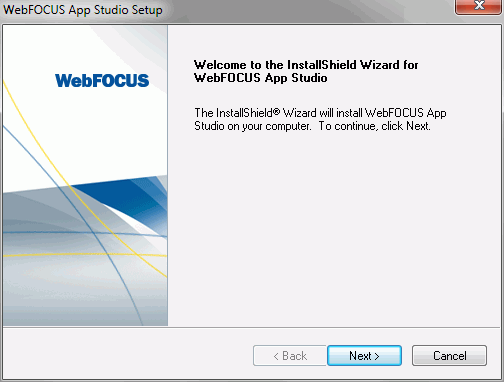
-
Click Next at
the Welcome window.
The License Agreement is displayed, as shown in the following image.
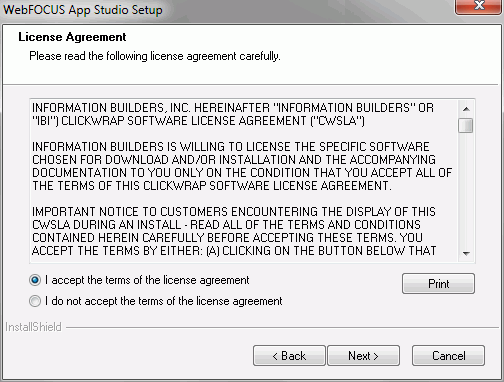
-
Select I
accept the terms of the license agreement if you accept
the License Agreement and then click Next.
The following image shows the Software Registration dialog box.
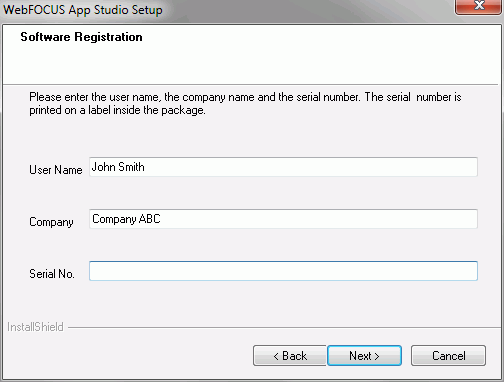
-
Type the
product serial number when prompted and click Next.
The serial number is based on your license agreement and controls the software edition that is installed.
If you type a valid serial number, the Registration Confirmation window appears.
-
Click Yes to
accept the Registration Confirmation.
A window appears, describing App Studio requirements, as shown in the following image.
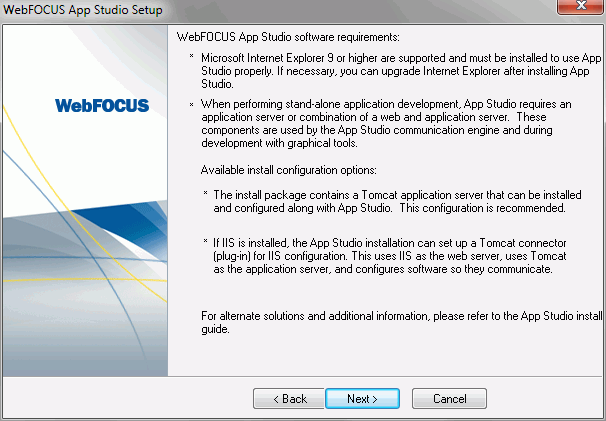
-
Review the
requirements and then click Next.
The Select Program Folder window opens, as shown in the following image.
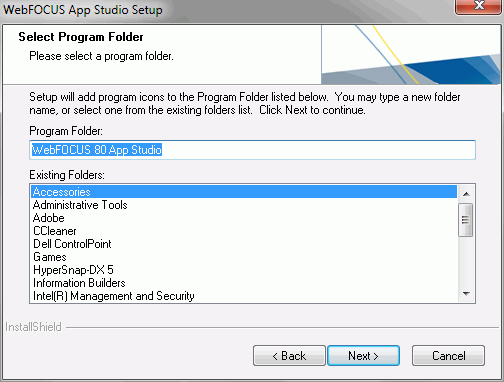
You can change the Program Folder name by adding a suffix. Changing the default name will also change the folder name where App Studio will be installed. For example, if the default folder name is WebFOCUS 80 App Studio, the product will be installed in a directory with the name ...\AppStudio80.
-
Accept the
default program folder, or specify a new one, and click Next.
The Choose Destination Location window opens, as shown in the following image.
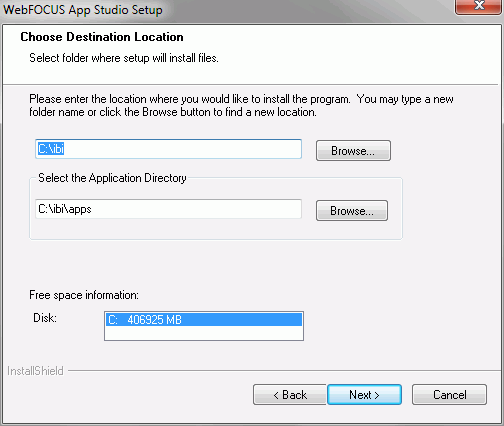
-
Specify
the following locations, or accept the default values:
-
Product Installation Directory. This
contains the software executable files. The new software will be
placed in this directory.
Accept the default value or click Browse to select a different directory.
-
Application Directory. This contains
the sample applications that come with the product, and is the location
where you create stand-alone applications.
Accept the default value or click Browse to select a different directory.
- Disk. If there is more than one disk or shared folder to which the software can be installed, select the one on which you want to install.
-
Product Installation Directory. This
contains the software executable files. The new software will be
placed in this directory.
-
Click Next.
The WebFOCUS App Studio Setup window opens. This options that display are specific to the edition of App Studio that you are installing.
The following image shows the WebFOCUS App Studio Setup window that displays when you license the App Studio edition or App Studio Visual Discovery edition of the product. This means that you can perform local or stand-alone development, remote development, and have full access to all of the features that are available in App Studio.
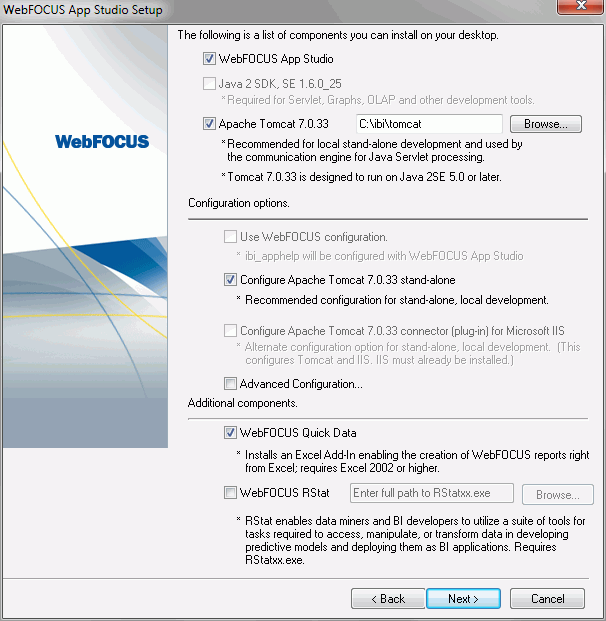
This window includes the following options. If an option is already installed or unavailable, it is grayed out:
- WebFOCUS App Studio. When selected, this installs the App Studio development environment. This option is required.
-
Java 2 SDK, SE 1.6.0_25. When
selected, this installs Java components needed for App Studio. If
Java SDK 1.5 or higher is not already installed, you must install
this SDK.
Note: This option is not enabled if version 1.6.0_25 or higher is already installed.
-
Apache Tomcat 7.0.33 When
selected, this installs Apache Tomcat for use as the web and/or
application server. Select this option to configure the App Studio
Help locally on your machine.
Note: This option is not enabled if a supported version of Tomcat is detected.
The following configuration options appear:
- Use WebFOCUS configuration. This option is visible if WebFOCUS is detected on the same PC. When selected, the installation continues and will not allow customizable configurations.
- Configure Apache Tomcat 7.0.33 stand-alone. When selected, this configures the detected or installed Apache Tomcat version for use with App Studio as both a web and application server. This can also be manually configured, as explained in Configuring Additional Web and/or Application Servers. Select this option to configure the App Studio Help locally on your machine. If the option to use the WebFOCUS Configuration is selected, the Tomcat configuration is enabled, and will create an App Studio Help context that does not affect the WebFOCUS configuration.
- Configure Apache Tomcat 7.0.33 connector (plug-in) for Microsoft IIS. When selected, this configures Apache Tomcat as the application server, configures IIS as the web server, and configures communications between IIS and Tomcat. IIS must be installed to use this option. This can also be manually configured, as explained in Configuring Additional Web and/or Application Servers.
-
Advanced Configuration. When
selected, this configures the aliases and context roots created
during the installation and provides optional settings to customize
them. Customizing the available options ensures they are different
from the aliases and context roots used by WebFOCUS or an earlier
version of App Studio in case you select the option to have multiple
installations.
Select this option to configure the App Studio Help remotely. The Web Server and Application Server Configurations window opens, as shown in the following image.
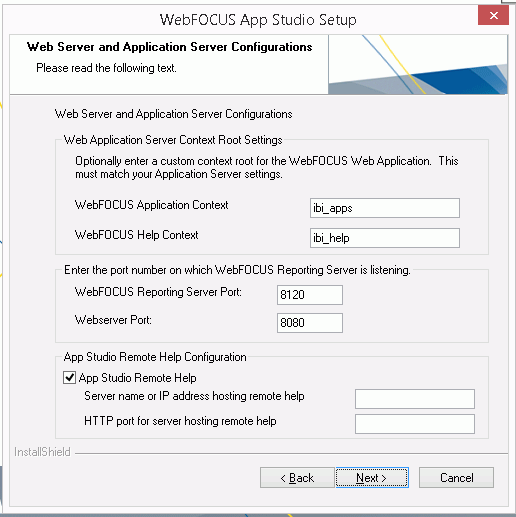
Note: This option is only available if you clear the Configure Apache Tomcat stand alone check box in the previous window.
-
WebFOCUS Quick Data. This
option installs an Excel Add-In that allows developers to create
WebFOCUS reports directly from Microsoft Excel. Developers create
reports using InfoAssist, and output is displayed in the active Excel
Workbook.
Enabling this option through App Studio provides a single-user license applicable only to the App Studio user. This option also functions against the local App Studio environment or against licensed WebFOCUS environments.
This feature must be licensed separately for use in multi-user WebFOCUS environments. This also applies when App Studio and WebFOCUS are installed on the same PC. For additional information, see Technical Memo 4649: Using WebFOCUS Quick Data Add-in.
-
WebFOCUS RStat. WebFOCUS
RStat is a statistical modeling workbench embedded in App Studio.
It allows you to perform common statistical and data mining tasks,
and develop models that can be deployed as scoring applications
on every platform. RStat enables data miners and Business Intelligence
developers to collaborate with the same features used to access, manipulate,
or transform data, develop predictive models, and create and deploy scoring
applications along with associated reports to any worker within
their organization.
WebFOCUS RStat includes:
- Intuitive user interface in App Studio to access the most widely used statistical and data mining models: decision trees, neural networks, linear and logistic regressions, random forests, support vector machine, boosting, association rules, K-means, and hierarchical clustering.
- Ability to prepare the data. For example, extract it from any data source, manipulate and transform fields to prepare data for analysis, and perform the modeling in App Studio.
- Access to a simple web form so that you can, with the click of a button, generate scores and predictions without having to know anything about data mining and modeling.
- Ability to perform common data exploration tasks and various distribution tests in order to determine the most appropriate modeling technique.
- Ability to explore the data visually with a robust set of charts and interactive visualizations.
- Incorporate predicted values and scores into any WebFOCUS report so that users can benchmark their intuitions and expert opinions to ensure that they have taken all factors into consideration when making decisions.
- RStat is extensible through scripts and open source to leverage the numerous packages developed by industry experts and scientists to perform highly complex analyses and rapidly deploy applications.
For additional information on WebFOCUS RStat, see the Using WebFOCUS RStat for Predictive Analytics manual.
The WebFOCUS RStat software can be downloaded from the Customer Support site.
Note: These configuration options are available even if you select the option to use the WebFOCUS configuration. When you select the Advanced Configuration option to configure Tomcat, you are only able to configure the App Studio Help locally.
To manually configure a different application server, deselect the configuration options and refer to Configuring Additional Web and/or Application Servers.
The following image shows the WebFOCUS App Studio Setup window that displays when you license the Managed Reporting Developer edition, or Report Developer edition of the product. This means that you can perform remote development, and have access to specific features in App Studio.
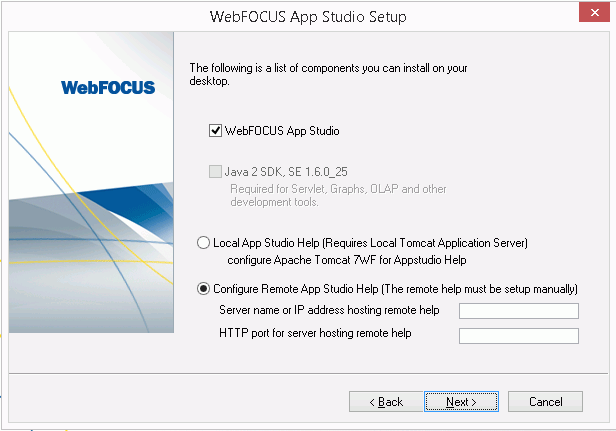
This window includes the following options. If an option is already installed or unavailable, it is grayed out:
- WebFOCUS App Studio. When selected, this installs the App Studio development environment. This option is required.
-
Java 2 SDK, SE 1.6.0_25. When
selected, this installs Java components needed for App Studio. If
Java SDK 1.5 or higher is not already installed, you must install
this SDK.
Note: This option is not enabled if version 1.6.0_25 or higher is already installed.
- Local App Studio Help (Requires Local Tomcat Application Server) configure Apache Tomcat 7WF for Appstudio Help. When selected, this installs Apache Tomcat as the application server for your App Studio Help.
-
Configure Remote App Studio Help (The remote help must be setup manually). When
selected, this configures App Studio so it accesses the Help on
a remote application server. If you choose this option, you need
to type a host name and port number based on the application server
that is hosting the Help system.
For more information about configuring the machine that will be hosting the remote Help, see Deploying the App Studio Help on a Remote Application Server.
-
Select the
components you wish to install and configure, and then click Next.
The Start Copying Files window opens, as shown in the following image.
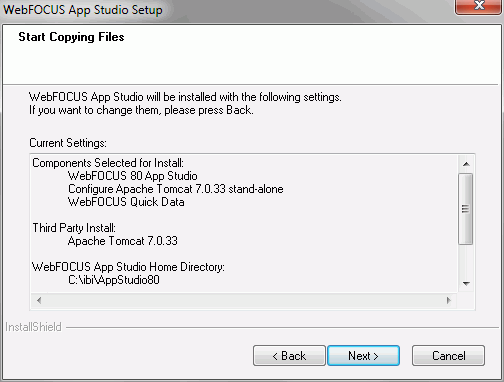
-
Review the
summary of tasks that will be performed during the install and click Next to
begin the installation.
An installation progress dialog box opens, as shown in the following image.
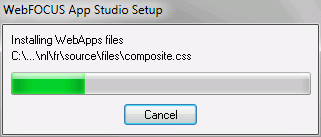
Once the installation has completed, the InstallShield Wizard Complete dialog box opens, as shown in the following image.
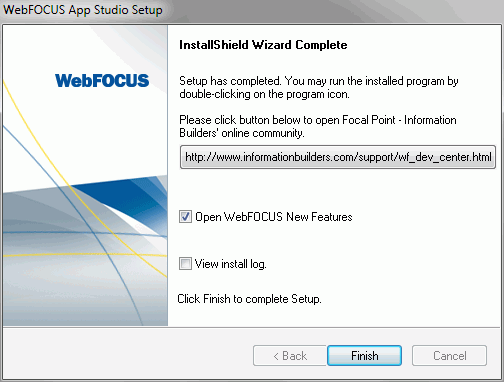
- Click Finish to complete the installation.
Note: If you choose the Tomcat connector (plug-in) option and receive a message that says Unable to Create Filter, some manual configuration is required. To do this, open the Internet Services Manager, right-click your website, and choose Properties. On the ISAPI Filters tab, determine if a Jakarta or ServletExec filter appears. If neither appear, click Add and add the isapi_redirect.dll file using the filter name Jakarta. For more information, review the remainder of this chapter and then see Configuring Microsoft IIS to Use the Tomcat Connector (Plug-in). Also, be aware that you cannot use the Tomcat plug-in if ServletExec ISAPI is installed.